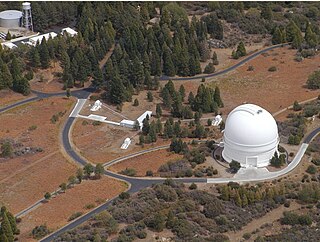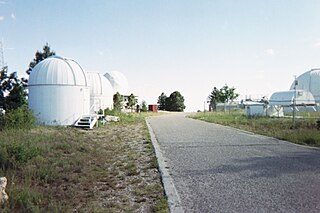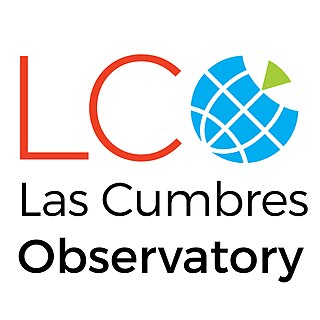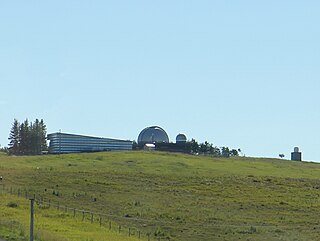Related Research Articles

The Kitt Peak National Observatory (KPNO) is a United States astronomical observatory located on Kitt Peak of the Quinlan Mountains in the Arizona-Sonoran Desert on the Tohono Oʼodham Nation, 88 kilometers (55 mi) west-southwest of Tucson, Arizona. With more than twenty optical and two radio telescopes, it is one of the largest gatherings of astronomical instruments in the Earth's northern hemisphere.

Sandra Moore Faber is an American astrophysicist known for her research on the evolution of galaxies. She is the University Professor of Astronomy and Astrophysics at the University of California, Santa Cruz, and works at the Lick Observatory. She has made discoveries linking the brightness of galaxies to the speed of stars within them and was the co-discoverer of the Faber–Jackson relation. Faber was also instrumental in designing the Keck telescopes in Hawaii.

Yerkes Observatory is an astronomical observatory located in Williams Bay, Wisconsin, United States. The observatory was operated by the University of Chicago Department of Astronomy and Astrophysics from its founding in 1897 to 2018. Ownership was transferred to the non-profit Yerkes Future Foundation (YFF) in May 2020, which began restoration and renovation of the historic building and grounds. Re-opening for public tours and programming began May 27, 2022.

The Lick Observatory is an astronomical observatory owned and operated by the University of California. It is on the summit of Mount Hamilton, in the Diablo Range just east of San Jose, California, United States. The observatory is managed by the University of California Observatories, with headquarters on the University of California, Santa Cruz campus, where its scientific staff moved in the mid-1960s. It is named after James Lick.

Palomar Observatory is an astronomical research observatory in San Diego County, California, United States, in the Palomar Mountain Range. It is owned and operated by the California Institute of Technology (Caltech). Research time at the observatory is granted to Caltech and its research partners, which include the Jet Propulsion Laboratory (JPL), Yale University, and the National Optical Observatories of China.

The American Association of Variable Star Observers (AAVSO) is an international nonprofit organization. Founded in 1911, the organization focuses on coordinating, analyzing, publishing, and archiving variable star observations made largely by amateur astronomers. The AAVSO creates records that establish light curves depicting the variation in brightness of a star over time. The AAVSO makes these records available to professional astronomers, researchers, and educators.

A robotic telescope is an astronomical telescope and detector system that makes observations without the intervention of a human. In astronomical disciplines, a telescope qualifies as robotic if it makes those observations without being operated by a human, even if a human has to initiate the observations at the beginning of the night or end them in the morning. It may have software agents using artificial intelligence that assist in various ways such as automatic scheduling. A robotic telescope is distinct from a remote telescope, though an instrument can be both robotic and remote.

Mount Hopkins is a 8,553-foot (2,607 m) peak of the Santa Rita Mountains range, in Santa Cruz County, southern Arizona.

South African Astronomical Observatory (SAAO) is the national centre for optical and infrared astronomy in South Africa. It was established in 1972. The observatory is run by the National Research Foundation of South Africa. The facility's function is to conduct research in astronomy and astrophysics. The primary telescopes are located in Sutherland, which is 370 kilometres (230 mi) from Observatory, Cape Town, where the headquarters is located.
The Robotic Lunar Observatory (ROLO) is an astronomical observatory funded by NASA and located at the United States Geological Survey Flagstaff Science Campus atop McMillan Mesa in Flagstaff, Arizona. Its purpose is to enable the Moon to be used as a radiometric calibration reference for Earth-orbiting remote-sensing spacecraft instruments. The ROLO project is currently ongoing, but the program ceased observations in September 2003. The facility is maintained for calibration and instrument characterization purposes. It consists of two 20 cm (7.9 in) Ritchey-Chrétien telescopes attached to an equatorial mount made by DFM Engineering. One telescope is fitted with a sensor optimized for visible and near-infrared (VNIR) wavelengths, while the other is tuned to short-wavelength infrared (SWIR). The VNIR camera began operations in 1995 and the SWIR camera in 1997.
Leuschner Observatory, originally called the Students' Observatory, is an observatory jointly operated by the University of California, Berkeley and San Francisco State University. The observatory was built in 1886 on the Berkeley campus. For many years, it was directed by Armin Otto Leuschner, for whom the observatory was renamed in 1951. In 1965, it was relocated to its present home in Lafayette, California, approximately 10 miles (16 km) east of the Berkeley campus. In 2012, the physics and astronomy department of San Francisco State University became a partner.


Mount Lemmon Observatory (MLO), also known as the Mount Lemmon Infrared Observatory, is an astronomical observatory located on Mount Lemmon in the Santa Catalina Mountains approximately 28 kilometers (17 mi) northeast of Tucson, Arizona (US). The site in the Coronado National Forest is used with special permission from the U.S. Forest Service by the University of Arizona's Steward Observatory, and contains a number of independently managed telescopes.

Alexei Vladimir "Alex" Filippenko is an American astrophysicist and professor of astronomy at the University of California, Berkeley. Filippenko graduated from Dos Pueblos High School in Goleta, California. He received a Bachelor of Arts in physics from the University of California, Santa Barbara in 1979 and a Ph.D. in astronomy from the California Institute of Technology in 1984, where he was a Hertz Foundation Fellow. He was a postdoctoral Miller Fellow at Berkeley from 1984 to 1986 and was appointed to Berkeley's faculty in 1986. In 1996 and 2005, he a Miller Research Professor, and he is currently a Senior Miller Fellow. His research focuses on supernovae and active galaxies at optical, ultraviolet, and near-infrared wavelengths, as well as on black holes, gamma-ray bursts, and the expansion of the Universe.

Las Cumbres Observatory (LCO) is a network of astronomical observatories run by a non-profit private operating foundation directed by the technologist Wayne Rosing. Its offices are in Goleta, California. The telescopes are located at both northern and southern hemisphere sites distributed in longitude around the Earth. For some astronomical objects, the longitudinal spacing of telescopes allows continuous observations over 24 hours or longer. The operating network currently consists of two 2 meter telescopes, nine 1 meter telescopes, and seven 40 cm telescopes, placed at six astronomical observatories. The network operates as a single, integrated, observing facility, using a software scheduler that continuously optimizes the planned observing schedule of each individual telescope.
Stephen J. Edberg is a scientist at the Jet Propulsion Laboratory. He is perhaps best known for creating collaborative efforts between amateur and professional astronomers. A professional astronomer since 1970, Edberg still considers himself to be an active amateur astronomer as well and is an active astronomical observer, photographer, and telescope maker. He presently serves as staff astronomer for the Solar System Exploration website posted by NASA Headquarters and staff scientist for Earth science communication and for Exoplanet Exploration communication.

Edward A. Halbach was an American amateur astronomer and prolific variable star observer.

Frederick Garnett Watson AM is an English-born astronomer and popular scientist in Australia. He holds the role of Australia's First Astronomer at Large within the Commonwealth Government of Australia, relaying the important aspects of Australian astronomy to the government, the general public, and associated organisations.

The Rothney Astrophysical Observatory (RAO) is an astronomical observatory located near the hamlet of Priddis, Alberta, Canada, about 20 kilometres (12 mi) southwest of Calgary. The observatory is owned and operated by the University of Calgary (UC), and was dedicated in 1972. The facility is used for research, undergraduate and graduate teaching, and public outreach. Research performed at the RAO included a variable star search program, follow-up observations of variable star discoveries, and detailed investigation of binary stars. An outstanding minor planet search program was also performed with comet discoveries by Rob Cardinal. The RAO is a link in the Skynet Robotic Telescope Network.
Mount Kent Observatory near Toowoomba, in the Darling Downs region of Queensland, Australia, is an observatory owned and operated by the University of Southern Queensland (USQ). It is the only professional astronomical research observatory in the state of Queensland. Mount Kent hosts the four MINERVA-Australis exoplanet-finding telescopes, three SONG telescopes for asteroseismology and stellar astrophysics, two 'Shared Skies' telescopes, and a USQ-Louisville telescope.
References
- ↑ "Orion Observatory: about Russell Genet" . Retrieved 2007-08-10.
- 1 2 3 "Russell M. Genet: Curriculum Vitae" (PDF). August 8, 2001. Retrieved 2007-08-10.
- 1 2 3 Staff. "Fairborn Observatory - the Orion Predecessor". OrionObservatory.org. Retrieved 9 January 2022.
- ↑ "Amateur Achievement winners" . Retrieved 2007-08-10.
- ↑ "The Leslie C. Peltier Award" . Retrieved 2007-08-13.
- ↑ "Orion Observatory: description" . Retrieved 2007-08-10.
- ↑ "Presidents of the Astronomical Society of the Pacific" . Retrieved 2007-08-10.
- ↑ "Orion Observatory: Russel Genet's Curriculum Vitae" . Retrieved 2007-08-10.
- ↑ "Alt-Az Initiative: Small Telescopes and Astronomical Research" . Retrieved 2009-11-01.
- ↑ "Russ and Cheryl Story" . Retrieved 2007-08-10.
- ↑ "Publications" . Retrieved 2007-08-10.
- ↑ "Collins Foundation Press" . Retrieved 2010-05-06.